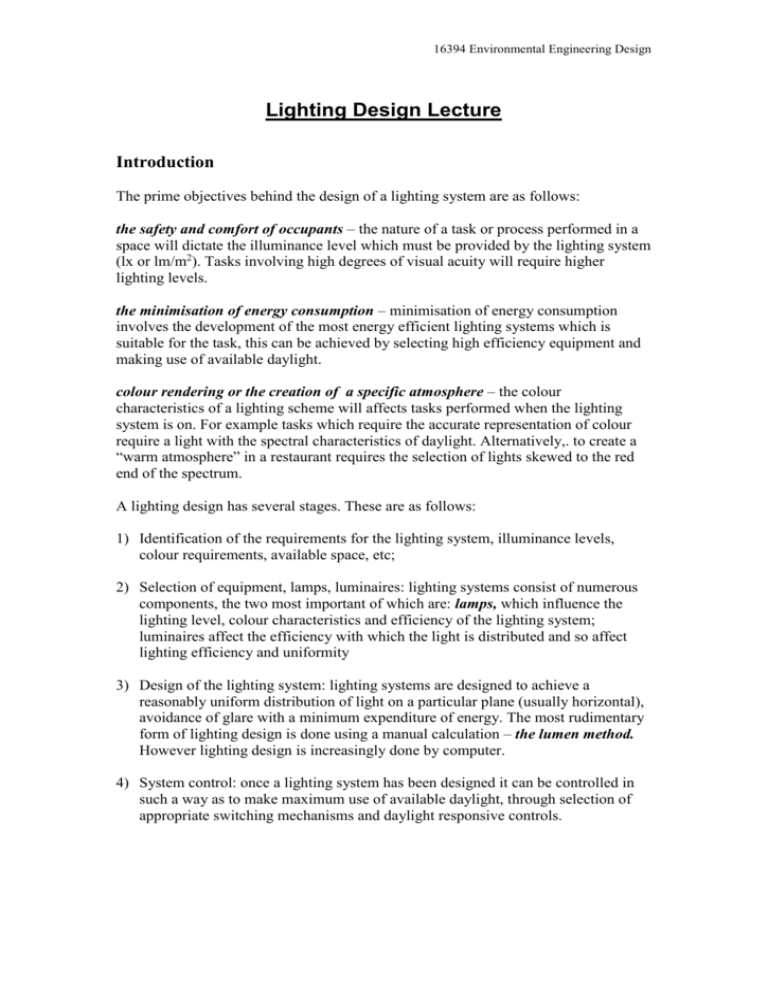Lighting Design Lecture
advertisement

16394 Environmental Engineering Design Lighting Design Lecture Introduction The prime objectives behind the design of a lighting system are as follows: the safety and comfort of occupants – the nature of a task or process performed in a space will dictate the illuminance level which must be provided by the lighting system (lx or lm/m2). Tasks involving high degrees of visual acuity will require higher lighting levels. the minimisation of energy consumption – minimisation of energy consumption involves the development of the most energy efficient lighting systems which is suitable for the task, this can be achieved by selecting high efficiency equipment and making use of available daylight. colour rendering or the creation of a specific atmosphere – the colour characteristics of a lighting scheme will affects tasks performed when the lighting system is on. For example tasks which require the accurate representation of colour require a light with the spectral characteristics of daylight. Alternatively,. to create a “warm atmosphere” in a restaurant requires the selection of lights skewed to the red end of the spectrum. A lighting design has several stages. These are as follows: 1) Identification of the requirements for the lighting system, illuminance levels, colour requirements, available space, etc; 2) Selection of equipment, lamps, luminaires: lighting systems consist of numerous components, the two most important of which are: lamps, which influence the lighting level, colour characteristics and efficiency of the lighting system; luminaires affect the efficiency with which the light is distributed and so affect lighting efficiency and uniformity 3) Design of the lighting system: lighting systems are designed to achieve a reasonably uniform distribution of light on a particular plane (usually horizontal), avoidance of glare with a minimum expenditure of energy. The most rudimentary form of lighting design is done using a manual calculation – the lumen method. However lighting design is increasingly done by computer. 4) System control: once a lighting system has been designed it can be controlled in such a way as to make maximum use of available daylight, through selection of appropriate switching mechanisms and daylight responsive controls. 16394 Environmental Engineering Design Identification of Lighting Requirements Lighting requirements are primarily dictated by the function of a space or the tasks being performed within it. Lighting requirements are usually specified by the required lighting level and the colour rendering requirements. For example: a general office requires an illumination level of 500 lux; colour rendering is mot particularly important; an architects drawing office requires higher lighting levels of 750 lux due the more visually tasks being conducted within the office. In addition as colour work is being done the lighting system must have good colour rendering. Examples of lighting level requirements are given in the table below: Building Area Entrance hall Corridors Kitchens General offices Drawing Rooms Standard Maintained Illuminance (lux) 200 100 300 500 750 Classrooms Lecture Theatres Art rooms 300 300 500 Colour Rendering Good colour rendering may be required Excellent colour rendering required Table 1 Lighting level requirements. Lighting requirements are summarised in the CIBSE Code for interior lighting, available from the library. The colour properties of a particular lamp are supplied by the manufacturer in the form of a lighting catalogue: the Philips lighting catalogue is available in the design room alternatively the catalogue is available on-line at: www.philips.com The colour rendering properties of a particular lamp are described by its colour rendering group or the CIE number (Commission Internationale de L’Eclairage): Colour rendering group 1A CIE colour rendering index (Ra) Ra > 90 1B 80 < Ra < 90 2 60 < Ra < 80 Comments Used wherever accurate colour matching is required Used when accurate colour matching is required e.g. clothes shops Where moderate colour rendering is 16394 Environmental Engineering Design 3 4 required 40 < Ra < 60 Where colour rendering is unimportant but distortion of colour is unacceptable 60 > Ra Where marked colour distortion is acceptable e.g. street lighting Table 2 Colour rendering groups Selection of Components Selection of components follows from the identification of systems requirements. The luminaires are normally chosen first: lighting catalogues usually describe the uses for particular types of luminaire, these also come with different types of reflectors1 for different applications e.g. low glare reflectors for computer rooms. casing lamp reflector Figure 1 The components of a typical luminaire. Lamps are selected based on those which are compatible (lamp type, dimensions, frequency of operation, etc) with the selected luminaire and which have the appropriate colour-rendering index. For example the Philips TCS 660 luminaire comes with a choice of 8 different reflector types. The lamps that can be fitted to this luminaire must be Philips high frequency fluorescent tubes that can be 1200mm or 1500 mm long. The luminaire can be fitted with a maximum of 2 fluorescent tubes. 1 Reflectors govern the light output characteristic of a luminaire. 16394 Environmental Engineering Design Design of the Lighting System A simple means of designing lighting systems is achieved by means of the lumen method; this is a simplified design approach to enable the designer to achieve an even light distribution in spaces of reasonably simple geometry (i.e. rectangular). The basis of the lumen method is the following equation: N E A n F MF UF (1) N - is the number of luminaires required; E - is the required illuminance (lux); A - is the area to be lit; N - is the number of lamps per luminaire; F - is the lamp lumen output (lumens); MF - is known as the maintenance factor, which is a combination of three factors; UF - is the utilisation and is a function of the luminaire properties and room geometry. Utilisation Factor (UF) The room geometry is a crucial factor in determining the utilisation factor term in the lumen equation. Several parameters are important. length L width W ceiling cavity ceiling plane hm working plane floor cavity Figure 2 important dimensional parameters for the Lumen Method In the Lumen method of design the room geometry is characterised by a room index (K): K L W ( L W )hm (2) 16394 Environmental Engineering Design The reflectances (ρs) of surfaces are also important properties in the calculation of terms for equation (1). The reflectances of walls floors and ceilings is represented by a number between 0 and 1: 0 – no light is reflected back from the surface, 1 – all incident light is reflected back from the surface. The calculation of surface reflectances is more complicated for imaginary planes such as the luminaire and working planes, in these cases the reflectances of these planes must be calculated as an equivalent cavity reflectance (ρe): n e A s 1 n i i A s 1 i (3) Where n is the number of surfaces in the cavity and A is the area of the surface within the cavity. The utilisation factor can be obtained once the surface reflectances (or effective reflectances) are known along with the room index (K); each luminaire produced by a manufacturer has a lookup table for UF (UF values in bold): Reflectances Room Index (K) Ceiling Wall floor 0.75 1.00 … 5.00 0.7 0.3 0.2 0.45 0.51 … 0.69 Table 3 Utilisation Factors Maintenance Factor (MF) The maintenance factor is a value designed to account for the reduction in light output from a lighting system due to: the ageing of the lamps and the accumulation of dirt and dust on the light fittings and room surfaces. The MF is therefore time varying and is the product of 4 factors: Lamp lumen maintenance factor (LLMF) – a value between 0 and 1 which accounts for the degradation of lamp output over time: lumen output at time t initial lumen output The LLMF for any time t can be obtained from manufacturer’s data. LLMF (t ) Lamp survival factor (LSF) – this accounts for the failure of lamps over time, if failed lamps are replaced immediately this factor can be ignored. Luminaire maintenance factor (LMF) – a value between 0 and 1 that accounts for dirt and dust accumulation on the luminaire. The luminaire maintenance factor




